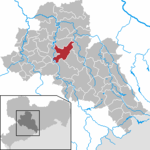Sachsenburg concentration camp

Sachsenburg was a Nazi concentration camp in eastern Germany, located in Frankenberg, Saxony, near Chemnitz. Along with Lichtenburg, it was among the first to be built by the Nazis, and operated by the SS from 1933 to 1937. The camp was an abandoned four-story textile mill which was renovated in May 1933 to serve as a "protective custody" facility for dissidents such as Jehovah's Witnesses, who opposed the Nazi regime.Sachsenburg was the first concentration camp in which SS used colored triangles sewn onto clothing, as well as armbands, to identify categories of prisoners. Details about the operation of Sachsenburg, held in 17 files (each containing several hundred SS reports) by the International Tracing Service, only became available to researchers in late 2006.
Excerpt from the Wikipedia article Sachsenburg concentration camp (License: CC BY-SA 3.0, Authors, Images).Sachsenburg concentration camp
An der Zschopau,
Geographical coordinates (GPS) Address Nearby Places Show on map
Geographical coordinates (GPS)
| Latitude | Longitude |
|---|---|
| N 50.932358333333 ° | E 13.026883333333 ° |
Address
An der Zschopau 6
09669
Saxony, Germany
Open on Google Maps









